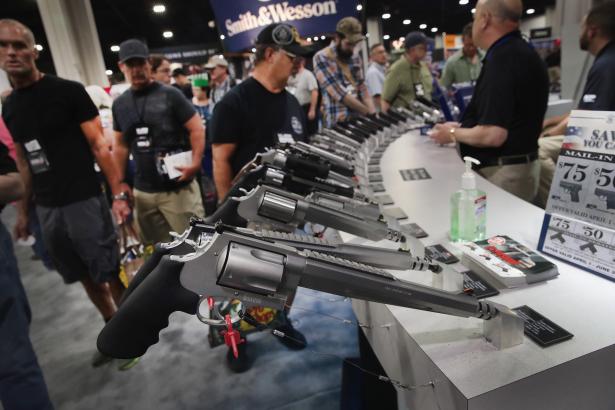It’s already become part of the national mourning ritual: after the latest horrifying mass shooting, liberals assail Republicans’ rote offerings of “thoughts and prayers” to the victims, juxtaposing these empty statements with the amount of “blood money” they’ve received from the National Rifle Association (NRA). Stupefied by the inaction of elected officials, they look for an explanation and find it in the putatively stunning sums buying off these politicians.
So after seventeen people were murdered at a Florida high school last week, Igor Volsky, who pioneered the tactic as a vice president at the Center for American Progress, took to Twitter to quote politicians and add comments like “With all due respect, @SenAlexander we need you to give back the $5,857 you got from @NRA and actually do your job and pass legislation that would reduce the number of guns in circulation. #SendBackTheBloodMoney”
Thousands of others followed suited. Joan Walsh — former editor in chief of Salon and current national affairs correspondent for the Nation — offered a typical message: “’This is pure evil,’ says @SpeakerRyan, about the Parkland massacre. Yes, it IS pure evil that you’ve done the bidding of the gun lobby that’s given you $171K.”
But while the NRA is a significant donor to GOP politicians, blaming the failure of gun control legislation on the organization’s financial largesse reflects a serious misunderstanding of where its power comes from. Paul Ryan raised $19,811,896 in 2016; the NRA’s $171,000 accounted for less than 1 percent of his haul. Lamar Alexander raked in more than $8 million for his 2014 reelection campaign; the NRA’s $5,857 is barely enough to buy a photo with a senator, much less get one to sponsor legislation.
What truly distinguishes the NRA is simple: it has a lot of people who are deeply involved and vote accordingly. Lobbying is just one of the NRA’s faces; it’s also a community organization that attracts people through service provision. Every year, 1 million people receive NRA firearms training. And the organization continues to expand its services. Last year it introduced a program that provides not only concealed carry training, but concealed carry insurance (covering up to a million dollars in legal costs associated with “self-defense shootings”), a hotline for incident reporting, complementary coverage for the policyholder’s spouse, and a subscription to NRA Carry Guard Magazine. What’s more, as political scientist Hahrie Han and others have noted, many of these services give members an opportunity to deepen their involvement and become leaders. Did you enjoy the firearms training you received? Well, the NRA can certify you to join the 125,000 training instructors in its network.
The result of all this is that the NRA boasts 5 million dues-paying members — who fund roughly half of the organization’s $337 million annual budget — and close to 15 million Americans who identify as NRA members even if they don’t pay dues. The organization’s services and leadership opportunities coalesce into something more: a group identity that mobilizes both actual members and the millions of others who think of themselves as the kind of person who belongs to the NRA.
One facet of that identity is rooted in race. The numbers are striking: last year, when the Pew Research Center asked, “What do you think is more important — to protect the right of Americans to own guns, OR to control gun ownership?” 73 percent of blacks and 69 percent of Hispanics said it was more important to control gun ownership while 55 percent of whites said protecting gun rights was more important. Other studies back this up: fear of crime actually predicts support for gun control, while racial resentment is a far better predictor of opposition to gun control. This is hardly surprising in a country where many whites long saw citizenship as entitling them to violently dispossess and enslave people of color. Any real effort to counter the NRA’s influence must take seriously its ability to mobilize millions and the content of the identity that’s mobilizing them.
In other words, elected officials aren’t simply bought off. Their inaction is the product of both years of organizing and deeper, systematic problems.
After decades of anti-union attacks, the liberal-left landscape is largely barren of mass organizations that provide services and leadership opportunities comparable to what the NRA offers. Planned Parenthood is a notable exception, but while they dispense essential services, they can’t furnish the same kind of opportunities for training and leadership development (at least until they open their own medical schools). And unlike the NRA, they receive significant government funding and therefore have had to mobilize to defend against right-wing attacks. Some gun control groups claim millions of members, but it’s easy to compile those numbers when membership just means getting emails rather than paying dues. There are no genuine mass organizations that work to stem gun violence.
None of which is to say that the NRA’s money doesn’t matter. Beyond direct donations, the NRA spent $55 million in 2016 on independent campaign expenditures — things like running ads to demonize Democratic candidates and so on. Those sums were truly unprecedented for them – triple what they’d spent in 2012. Whether this represented a one-time swing driven by the opportunity to place all three branches of government under Republican control or a long-term shift toward greater outlays is unclear. But in either case, it’s important to recognize that such spending isn’t what made the NRA so powerful in the first place. It is the fact — much as it might pain the organization’s opponents to admit — that the NRA has a real mass base.


Spread the word